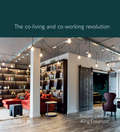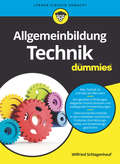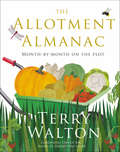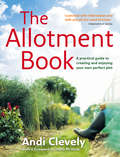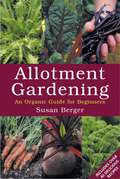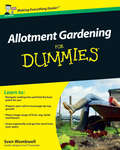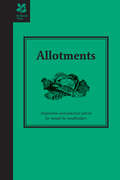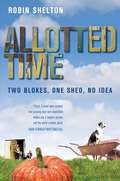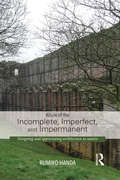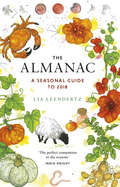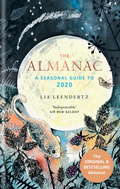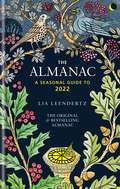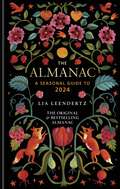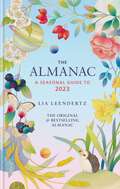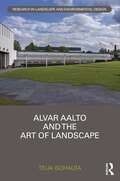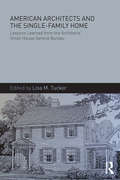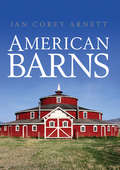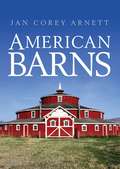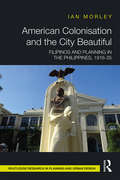- Table View
- List View
All Together Now: The co-working and co-living revolution
by Naomi Cleaver Amy FrearsonCollaborative spaces have been hailed as either the solution to the 21st century’s culture of overwork and broken housing market, or as an unworkable and impractical aspiration. Designing for such spaces has its particular challenges and considerations, especially in how to deliver attractive, healthy and efficient collaborative places. A practical and inspirational design guide, this book draws on the author's own experience, as well as the work of others, offering workable and practical solutions, and showcases a huge variety of different kinds of collaborative spaces across the globe. Including detailed and illustrated case studies across the co-living, co-working typologies – both new build and conversion, at different scales and in different settings – it concludes with a best practice toolkit, giving practical advice and lessons for all designers working at any scale. Case studies include: *The Project, Hoxton, London *Outpost, Bali *Venn, Tel Aviv
All Together Now: The co-working and co-living revolution
by Naomi Cleaver Amy FrearsonCollaborative spaces have been hailed as either the solution to the 21st century’s culture of overwork and broken housing market, or as an unworkable and impractical aspiration. Designing for such spaces has its particular challenges and considerations, especially in how to deliver attractive, healthy and efficient collaborative places. A practical and inspirational design guide, this book draws on the author's own experience, as well as the work of others, offering workable and practical solutions, and showcases a huge variety of different kinds of collaborative spaces across the globe. Including detailed and illustrated case studies across the co-living, co-working typologies – both new build and conversion, at different scales and in different settings – it concludes with a best practice toolkit, giving practical advice and lessons for all designers working at any scale. Case studies include: *The Project, Hoxton, London *Outpost, Bali *Venn, Tel Aviv
Allgemeinbildung Technik für Dummies (Für Dummies)
by Wilfried SchlagenhaufOb Smartphone, Auto oder Kühlschrank - unser Alltag spielt sich in einer technisch geprägten Welt ab. In diesem Buch begleitet Wilfried Schlagenhauf Sie durch die faszinierende Welt der technischen Kultur. Nach der Lektüre dieses Buches werden Sie über manches technische Phänomen besser Bescheid wissen, die zugrundeliegenden Konstruktions- und Funktionsprinzipien kennen und technische Lösungen als clevere Antworten auf menschliche Bedürfnisse verstehen. Und es wird Ihnen leichter fallen, technische Produkte auszuwählen, zu bewerten und Kaufentscheidungen zu treffen. Spezielles Vorwissen naturwissenschaftlicher oder mathematischer Art brauchen Sie dazu nicht, versprochen! Lassen Sie sich technik-begeistern!
The Allotment Almanac: Month-by-month On The Plot
by Terry WaltonFrom a gardener who has been working on his allotment for over 50 years, a brilliant guide to organic vegetable growing and allotment life in general. Month by month Terry give us:An overview of the plotThings to do this monthWhat to watch out forKey crops for the monthProgress reports on all the standard vegTop variety tipsMain tasks for the monthAllotment TalesWith all the charm that shone through My Life on a Hillside Allotment, Terry takes the gardening reader by the hand and leads them through the gardening year. He is the perfect companion, giving technical help, quick tips, reassurance, and plenty of entertainment along the way.
The Allotment Book: Seasonal Planner And Cookbook
by Andi ClevelyA wonderfully illustrated celebration of the blood, sweat and joy to be had ‘growing your own’ in an allotment – with the in-depth, practical gardening know-how for which Collins is renowned.
Allotment Gardening: An Organic Guide for Beginners
by Susan BergerGrow your own organic fruit and vegetables with this practical guide to setting up and maintaining an allotment garden.Allotments provide a wonderful opportunity to connect with nature and become more self-sufficient, growing fresh produce to cook with. But getting started on your plot can sometimes feel a bit daunting. Written by garden designer Susan Berger and illustrated throughout with drawings and photographs, Allotment Gardening is packed with advice on growing and maintaining your allotment garden – from choosing and planning your allotment through to harvesting and storing your produce. The first half of this handy guide discusses allotment basics, such as what tools to buy and how to plan and clear your site. Susan then shares useful information on crop rotation, planting and how to protect plants against pests and harsh weather. She also looks at design and growing techniques, including feeding plants, mulching, saving seeds and supporting plants, and how to prevent and cope with common problems. The second half of the book focuses on the cultivation of individual fruit, vegetables, flowers and herbs, along with recommendations for particular varieties chosen for their flavour, and ideas for companion planting. There are detailed instructions on how to store produce efficiently, as well as tips on herb usage. Each fruit and vegetable entry features an easy recipe to help you make the most of your fresh produce, such as pea soup, Frizzled Brussels Sprouts, Sautéed Kohl Rabi, jam and pudding. Ideal for beginner gardeners growing on their first site, Allotment Gardening also includes a gardener's calendar with monthly activities, and a directory of seed suppliers and useful organisations.
Allotment Gardening For Dummies
by Sven WombwellAllotment Gardening For Dummies is a lively, hands-on guide to getting the most out of your allotment. Whether you're interested in eating fresh, saving money, getting exercise or enjoying wholesome family fun, this is the guide for you. The step-by-step advice takes you through all the stages in the process, from securing an allotment and preparing your plot, to choosing what to grow and enjoying the benefits of abundant fresh food and a sociable and healthy hobby. With over 50 handy line drawings, plus information on how to grow organic and advice on storing and cooking the food you grow, this guide really does have it all! Allotment Gardening For Dummies includes: Part 1: Getting to Grips with Allotment Gardening Chapter 1: What Are Allotments All About? Chapter 2: Getting hold of an Allotment Chapter 3: Getting Started Part 2: Preparing for Allotment Success Chapter 4: Deciding What to Grow, When Chapter 5: Preparing Your Plot Chapter 6: Keeping Your Soil Healthy Chapter 7: Keeping Your Plants Healthy Chapter 8: Growing Organic Part 3: Growing a Few of Your Favourite Vegetables Chapter 9: Going Underground Chapter 10: The Staples Chapter 11: Growing Leafy Greens Chapter 12: Planting Peas, Beans and Other Pods Chapter 13: Growing More Exotic Veg Part 4: Extending Your Allotment Repetoire Chapter 14: Growing Wholesome Herbs Chapter 15: Growing Fruitful Fruit Chapter 16: Nurturing Flowers on an Allotment Part 5: Getting the Most Out of Your Allotment Chapter 17: Involving Children Around the Allotment Chapter 18: Hobnobbing with Allotment Society Chapter 19: Growing Giant Veg Part 6: The Part of Tens Chapter Chapter 20: Ten Common Accidents and How to Prevent Them Chapter 21: Ten Ways to Revive a Flagging Allotment
Allotment Gardening For Dummies
by Sven WombwellAllotment Gardening For Dummies is a lively, hands-on guide to getting the most out of your allotment. Whether you're interested in eating fresh, saving money, getting exercise or enjoying wholesome family fun, this is the guide for you. The step-by-step advice takes you through all the stages in the process, from securing an allotment and preparing your plot, to choosing what to grow and enjoying the benefits of abundant fresh food and a sociable and healthy hobby. With over 50 handy line drawings, plus information on how to grow organic and advice on storing and cooking the food you grow, this guide really does have it all! Allotment Gardening For Dummies includes: Part 1: Getting to Grips with Allotment Gardening Chapter 1: What Are Allotments All About? Chapter 2: Getting hold of an Allotment Chapter 3: Getting Started Part 2: Preparing for Allotment Success Chapter 4: Deciding What to Grow, When Chapter 5: Preparing Your Plot Chapter 6: Keeping Your Soil Healthy Chapter 7: Keeping Your Plants Healthy Chapter 8: Growing Organic Part 3: Growing a Few of Your Favourite Vegetables Chapter 9: Going Underground Chapter 10: The Staples Chapter 11: Growing Leafy Greens Chapter 12: Planting Peas, Beans and Other Pods Chapter 13: Growing More Exotic Veg Part 4: Extending Your Allotment Repetoire Chapter 14: Growing Wholesome Herbs Chapter 15: Growing Fruitful Fruit Chapter 16: Nurturing Flowers on an Allotment Part 5: Getting the Most Out of Your Allotment Chapter 17: Involving Children Around the Allotment Chapter 18: Hobnobbing with Allotment Society Chapter 19: Growing Giant Veg Part 6: The Part of Tens Chapter Chapter 20: Ten Common Accidents and How to Prevent Them Chapter 21: Ten Ways to Revive a Flagging Allotment
Allotments (Countryside Ser.)
by Jane EastoeAn allotment is one of the best – and cheapest ways – of getting hold of valuable gardening space to grow you own. Plus it offers one of the most relaxing atmospheres with the chance to mix with fellow gardeners. Your allotment can provide enough fruit, veg and herbs to feed most small families (and cut flowers to adorn the kitchen table) – produce that will taste and look much better than anything shop bought. Jane Eastoe guides you through allotment life, from how to find an allotment, how to plan one out, what to grow, crop rotation, how to store your harvest plus some of the best recipes so you enjoy the fruits of your labour. Great gardening information is given for each crop – the obvious to the not so obvious – from potatoes and carrots to aubergines and chillies. What to grow when, what to grow where plus a calendar of work for the laziest to the most energetic allotment holder. With all the details on the cost of having an allotment, self-management, and protecting your allotment, this is the easiest guide to getting starting on allotment life. In addition to all the practical gardening techniques, this eBook has background information on local authority control, self-management options, and how to protect your allotment.
Allotted Time: Two Blokes, One Shed, No Idea
by Robin SheltonRobin Shelton and his mate Steve were complete neophytes when they decided that having an allotment might save them a bit of money. But what had seemed like a good idea over a couple of beers seemed rather more daunting when faced with a weedy patch of ground. Still, both men were at a crisis point in their lives and the allotment represented their desire to achieve something concrete. They persevered and, despite the weather and confusing advice from their elderly allotment neighbours, managed to plant and grow a successful crop of vegetables. As he writes about their year in the allotment, Robin describes his own personal journey. When he takes the allotment on he is divorced, broke and suffering from depression. Working on the allotment brings back happy memories of his father, who died when Robin was sixteen, and also draws him closer to his own two sons. Gradually Robin finds stability and a sense of purpose in his life. His and Steve's tale is funny, moving and enlightening - a book for anyone who's ever bitten off more than they can chew, but muddled through anyway. "Their struggle to plant their crops against the baffling advice of fellow allotment holders is funny and moving. Our heroes finish the year wiser, saner and with an impressive array of veg." Daily Express "A comforting antidote to the glossy perfection of gardening on the telly." Evening Standard
Allure of the Incomplete, Imperfect, and Impermanent: Designing and Appreciating Architecture as Nature
by Rumiko HandaArchitects have long operated based on the assumption that a building is 'complete' once construction has finished. Striving to create a perfect building, they wish for it to stay in its original state indefinitely, viewing any subsequent alterations as unintended effects or the results of degeneration. The ideal is for a piece of architecture to remain permanently perfect and complete. This contrasts sharply with reality where changes take place as people move in, requirements change, events happen, and building materials are subject to wear and tear. Rumiko Handa argues it is time to correct this imbalance. Using examples ranging from the Roman Coliseum to Japanese tea rooms, she draws attention to an area that is usually ignored: the allure of incomplete, imperfect and impermanent architecture. By focusing on what happens to buildings after they are ‘complete’, she shows that the ‘afterlife’ is in fact the very ‘life’ of a building. However, the book goes beyond theoretical debate. Addressing professionals as well as architecture students and educators, it persuades architects of the necessity to anticipate possible future changes and to incorporate these into their original designs.
Allure of the Incomplete, Imperfect, and Impermanent: Designing and Appreciating Architecture as Nature
by Rumiko HandaArchitects have long operated based on the assumption that a building is 'complete' once construction has finished. Striving to create a perfect building, they wish for it to stay in its original state indefinitely, viewing any subsequent alterations as unintended effects or the results of degeneration. The ideal is for a piece of architecture to remain permanently perfect and complete. This contrasts sharply with reality where changes take place as people move in, requirements change, events happen, and building materials are subject to wear and tear. Rumiko Handa argues it is time to correct this imbalance. Using examples ranging from the Roman Coliseum to Japanese tea rooms, she draws attention to an area that is usually ignored: the allure of incomplete, imperfect and impermanent architecture. By focusing on what happens to buildings after they are ‘complete’, she shows that the ‘afterlife’ is in fact the very ‘life’ of a building. However, the book goes beyond theoretical debate. Addressing professionals as well as architecture students and educators, it persuades architects of the necessity to anticipate possible future changes and to incorporate these into their original designs.
The Almanac: A Seasonal Guide to 2018
by Lia LeendertzThe Almanac revives the tradition of the rural almanac, connecting you with the months and seasons via moon-gazing, foraging, feast days, seasonal eating, meteor-spotting and gardening. Award-winning gardener and food writer Lia Leendertz shares the tools and inspiration you need to celebrate, mark and appreciate each moment of the year.
The Almanac: A Seasonal Guide to 2020
by Lia Leendertz*THE ORIGINAL & BESTSELLING ALMANAC *'Indispensable' - Sir Bob Geldof A perfect toolkit connecting with the world around us and the year ahead as it unfolds - all in a compact and pocket size that just begs you to pick it up and browse.The Almanac: A Seasonal Guide to 2020 reinvents the tradition of the rural almanac for a new audience. It gives you the tools and inspiration you need to celebrate, mark and appreciate each month of the year in your own particular way. Divided into the 12 months, a set of tables each month gives it the feel and weight of a traditional almanac, providing practical information that gives access to the outdoors and the seasons, perfect for expeditions, meteor-spotting nights and beach holidays. There are also features on each month's unique nature, such as the meteor shower of the month, beehive behaviour, folklore and stories, seasonal recipes and charts tracking moon phases and tides. You will find yourself referring to the almanac all year long, revisiting it again and again, and looking forward to the next edition as the year draws to a close. PRAISE FOR THE ALMANAC: A SEASONAL GUIDE:'The perfect companion to the seasons' - India Knight'This book is your bible' - the Independent 'An ideal stocking filler' - The English Garden 'I love this gem of a book' - Cerys Matthews
The Almanac: A seasonal guide to 2022
by Lia Leendertz*THE ORIGINAL & BESTSELLING ALMANAC*A perfect toolkit for connecting with the world around us and the year ahead as it unfolds - all in a compact and pocket size guide that just begs you to pick it up and browse.The Almanac: A seasonal guide to 2022 reinvents the tradition of the rural almanac for a new audience. It gives you the tools and inspiration you need to celebrate, mark and appreciate each month of the year in your own particular way. Divided into the 12 months, a set of tables each month gives it the feel and weight of a traditional almanac, providing practical information that gives access to the outdoors and the seasons, perfect for expeditions, meteor-spotting nights and beach holidays. There are also features on each month's unique nature, such as the meteor shower of the month, beehive behaviour, folklore, seasonal recipes and charts tracking moon phases and tides.You will find yourself referring to The Almanac all year long, revisiting it again and again, and looking forward to the next edition as the year draws to a close.PRAISE FOR THE ALMANAC:'The perfect companion to the seasons' - India Knight'Indispensable' - Sir Bob Geldof'This book is your bible' - The Independent'An ideal stocking filler' - The English Garden'I love this gem of a book' - Cerys Matthews
The Almanac: A Seasonal Guide To 2018 (Almanac)
by Lia LeendertzTHE ORIGINAL & BESTSELLING ALMANACReconnect with the seasons in Britain and Ireland with this month-by-month guide to the world around us - including tide tables, sunrises and moon phases; garden feasts, wildlife and folklore; seasonal recipes, snacks and more.The Almanac: A Seasonal Guide to 2024 gives you the tools and inspiration you need to celebrate, mark and appreciate each month of the year in your own particular way.Divided into the 12 months, a set of tables each month gives it the feel and weight of a traditional almanac, providing practical information that gives access to the outdoors and the seasons, perfect for expeditions, meteor-spotting nights and beach holidays. This year's edition focuses on the natural wonders of the garden, celebrating the beautiful flora and fauna at your doorstep. There are also features on each month's unique nature, plus a flower and a snack of the month.You will find yourself referring to The Almanac all year long, revisiting it again and again, and looking forward to the next edition as the year draws to a close.PRAISE FOR THE ALMANAC:'Lia Leendertz's classic almanac never fails to delight' - The Herald'It's a perfect Christmas present' - Allan Jenkins, The Observer'The perfect companion to the seasons' - India Knight'Indispensable' - Sir Bob Geldof'This book is your bible' - The Independent'I love this gem of a book' - Cerys Matthews
The Almanac: THE SUNDAY TIMES BESTSELLER (Almanac)
by Lia LeendertzTHE ORIGINAL & SUNDAY TIMES BESTSELLING ALMANAC Reconnect with the seasons in Britain and Ireland with this month-by-month guide to the world around us - including key dates, tide tables and garden tasks; constellations and moon phases; sunrises, folk songs, seasonal recipes plus a 'bun of the month'; and - because 2023 will be a good year for planet spotting - the solar system and the zodiac.The Almanac: A Seasonal Guide to 2023 gives you the tools and inspiration you need to celebrate, mark and appreciate each month of the year in your own particular way. Divided into the 12 months, a set of tables each month gives it the feel and weight of a traditional almanac, providing practical information that gives access to the outdoors and the seasons, perfect for expeditions, meteor-spotting nights and beach holidays. There are also features on each month's unique nature, with this instalment following the swirling micro world of the garden pond through the year.You will find yourself referring to The Almanac all year long, revisiting it again and again, and looking forward to the next edition as the year draws to a close.This year's edition is illustrated by artist Whooli Chen.The geographical scope of The Almanac is Britain and IrelandPRAISE FOR THE ALMANAC:'Lia Leendertz's classic almanac never fails to delight' - The Herald'It's a perfect Christmas present' - Allan Jenkins, The Observer'The perfect companion to the seasons' - India Knight'Indispensable' - Sir Bob Geldof'This book is your bible' - The Independent'I love this gem of a book' - Cerys Matthews
Alvar Aalto and The Art of Landscape (Routledge Research in Landscape and Environmental Design)
by Teija IsohautaAlvar Aalto and The Art of Landscape captures the essence of the Finnish architect’s landscape concept, emphasising culture and tradition, which characterised his approach to and understanding of architecture as part of the wider environment. From the forests of his youth to sights from his travels, Alvar Aalto (1898–1976) was influenced by outdoor landscapes. Throughout his career, he felt the need to shape the terrain and this became a signature of his architecture. Divided into five chapters, this book traces Aalto’s relationship with landscape, starting with an analysis of his definitions and descriptions of landscape language, which ranged from natural references and biological terms, to synonyms and comparisons. It includes beautifully illustrated case study projects from the 1950s and 1960s, discussing Aalto’s transformation of different landscapes through topography, terracing and tiers, ruins and natural elements, horizon outlines, landmarks, and the repetition of form. Featuring archival sketches, garden drawings, and plans, the book also contains Aalto’s text ‘Architecture in the Landscape of Central Finland’ from 1925 in the appendix. This book provides fascinating, untold insights into Aalto’s relationship with landscape and how this developed during his lifetime, for scholars, researchers, and students interested in architecture and landscape history, landscape art, and cultural studies.
Alvar Aalto and The Art of Landscape (Routledge Research in Landscape and Environmental Design)
by Teija IsohautaAlvar Aalto and The Art of Landscape captures the essence of the Finnish architect’s landscape concept, emphasising culture and tradition, which characterised his approach to and understanding of architecture as part of the wider environment. From the forests of his youth to sights from his travels, Alvar Aalto (1898–1976) was influenced by outdoor landscapes. Throughout his career, he felt the need to shape the terrain and this became a signature of his architecture. Divided into five chapters, this book traces Aalto’s relationship with landscape, starting with an analysis of his definitions and descriptions of landscape language, which ranged from natural references and biological terms, to synonyms and comparisons. It includes beautifully illustrated case study projects from the 1950s and 1960s, discussing Aalto’s transformation of different landscapes through topography, terracing and tiers, ruins and natural elements, horizon outlines, landmarks, and the repetition of form. Featuring archival sketches, garden drawings, and plans, the book also contains Aalto’s text ‘Architecture in the Landscape of Central Finland’ from 1925 in the appendix. This book provides fascinating, untold insights into Aalto’s relationship with landscape and how this developed during his lifetime, for scholars, researchers, and students interested in architecture and landscape history, landscape art, and cultural studies.
American Architects and the Single-Family Home: Lessons Learned from the Architects' Small House Service Bureau
by Lisa M. TuckerAmerican Architects and the Single-Family Home explains how a small group of architects started the Architects’ Small House Service Bureau in 1919 and changed the course of twentieth-century residential design for the better. Concepts and principles they developed related to public spaces, private spaces, and service spaces for living; details about the books they published to promote good design; as well as new essays from contemporary practitioners will inspire your own designs. More than 200 black and white images.
American Architects and the Single-Family Home: Lessons Learned from the Architects' Small House Service Bureau
by Lisa M. TuckerAmerican Architects and the Single-Family Home explains how a small group of architects started the Architects’ Small House Service Bureau in 1919 and changed the course of twentieth-century residential design for the better. Concepts and principles they developed related to public spaces, private spaces, and service spaces for living; details about the books they published to promote good design; as well as new essays from contemporary practitioners will inspire your own designs. More than 200 black and white images.
American Barns (Shire Library Usa Ser. #751)
by Jan Corey ArnettThe heart of every working farm and ranch, the barn is an icon of rural America. This book chronicles – and celebrates – all the main types, and looks at how these treasures of early American architecture developed. It explains how a wealth of immigrant construction methods and range of environments and climates resulted in a fascinating variety of barn styles in the United States, from the earliest rare Dutch examples to simpler English types and others in more surprising shapes (round or even polygonal) crafted by the Shakers in the 1800s. It highlights the most notable, famous and historic barns that the reader can visit, and features the efforts of conservation groups to preserve America's barns and find innovative ways to repurpose these glorious old structures as homes and studios – and as living monuments of rural heritage.
American Barns (Shire Library USA #751)
by Jan Corey ArnettThe heart of every working farm and ranch, the barn is an icon of rural America. This book chronicles – and celebrates – all the main types, and looks at how these treasures of early American architecture developed. It explains how a wealth of immigrant construction methods and range of environments and climates resulted in a fascinating variety of barn styles in the United States, from the earliest rare Dutch examples to simpler English types and others in more surprising shapes (round or even polygonal) crafted by the Shakers in the 1800s. It highlights the most notable, famous and historic barns that the reader can visit, and features the efforts of conservation groups to preserve America's barns and find innovative ways to repurpose these glorious old structures as homes and studios – and as living monuments of rural heritage.
American Colonisation and the City Beautiful: Filipinos and Planning in the Philippines, 1916-35
by Ian MorleyAmerican Colonisation and the City Beautiful explores the history of city planning and the evolution of the built environment in the Philippines between 1916 and 1935. In so doing, it highlights the activities of the Bureau of Public Works’ Division of Architecture as part of Philippine national development and decolonisation. Morley provides new archival materials which deliver significant insight into the dynamics associated with both governance and city planning during the American colonial era in the Philippines, with links between prominent American university educators and Filipino architecture students. The book discusses the two cities of Tayabas and Iloilo which highlight the significant role in the urban design of places beyond the typical historiographical focus of Manila and Baguio. These examples will aid in further understanding the appearance and meaning of Philippine cities during an important era in the nation’s history. Including numerous black and white images, this book is essential for academics, researchers and students of city and urban planning, the history and development of Southeast Asia and those interested in colonial relations.
American Colonisation and the City Beautiful: Filipinos and Planning in the Philippines, 1916-35
by Ian MorleyAmerican Colonisation and the City Beautiful explores the history of city planning and the evolution of the built environment in the Philippines between 1916 and 1935. In so doing, it highlights the activities of the Bureau of Public Works’ Division of Architecture as part of Philippine national development and decolonisation. Morley provides new archival materials which deliver significant insight into the dynamics associated with both governance and city planning during the American colonial era in the Philippines, with links between prominent American university educators and Filipino architecture students. The book discusses the two cities of Tayabas and Iloilo which highlight the significant role in the urban design of places beyond the typical historiographical focus of Manila and Baguio. These examples will aid in further understanding the appearance and meaning of Philippine cities during an important era in the nation’s history. Including numerous black and white images, this book is essential for academics, researchers and students of city and urban planning, the history and development of Southeast Asia and those interested in colonial relations.
